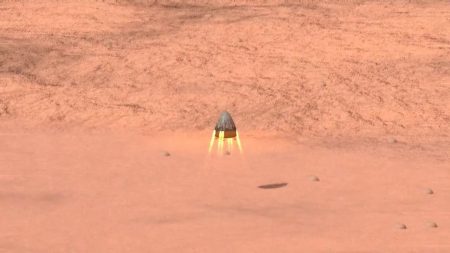July 28, 2016 – Imagine twenty years ago if a private company had made such an announcement. Who would have thought it was credible? But today if any private space company has the skill set to make a go of it in getting to Mars it is SpaceX.
The company and its founder, Elon Musk, are committed to getting a human colony established on the Red Planet sometime in the 2020s, a decade before NASA. Will they succeed? I’m not sure because Mars will be very hard as a place for humans to survive.
We have yet to master creating self-sustaining environments in any space venture to date. The International Space Station constantly requires supply replenishment and at worst a mission to it can take up to three days depending on the launch window. Consider its location in low-Earth orbit and now look at the distances to Mars and you can understand my skepticism.
Nonetheless, like so many past pioneers, Musk and his SpaceX enthusiasts are out to establish a new human frontier. There has been nothing like it since the Apollo missions, Columbus’ voyages to the Americas, the Vikings’ discovery of North America, and when humans first crossed the Beringia land bridge to North America.
So how will they pull it off for $300 million when NASA’s budget for a human mission to Mars runs into the hundreds of billions? SpaceX commitment to driving down the cost of getting to space is well noted. They have successfully launched a returned first stages of their Falcon 9 booster to Earth and intend to re-fly one of them sometime this fall. That sets a new economic paradigm.
SpaceX intends to reuse almost all of the rocket parts it sends into space, not just the first stage, as it continues to experiment with new technologies. This will be true for the Falcon Heavy, the latest launcher from the company that will be tested sometime before the end of this year. Only the Falcon Heavy will have the payload capacity to support a interplanetary mission capable of delivering an enhanced Dragon 2.0 capsule, called the Red Dragon, to Mars.
What’s interesting is how NASA intends to assist SpaceX in the Red Dragon mission. For every $10 SpaceX is planning to spend, NASA will contribute $1. NASA’s investment will be in the from of expertise including defining landing sites on Mars, hardening the Dragon to withstand interplanetary space travel, and providing access to the agency’s Deep Space communication network.
For this help NASA will fly along in sharing all the data SpaceX collects. The big interest for NASA is seeing how the SpaceX landing technology pans out in the descent to the Martian surface. Aerobraking such as is done by capsules, the former American shuttle, and the Falcon 9 is not possible on Mars. SpaceX must perfect an ability to do supersonic retro-propulsion. To date the heaviest object to land on Mars is the Curiosity rover weighing approximately one ton. Red Dragon will be almost 10 times that weight and those Draco engines built into the current version 2.0 of the technology will not provide enough counter-thrust to stop the capsule from a bone-crushing crash. For later planned missions with human crews, the landing capsules will weigh significantly more than the 10 tons expected for the Red Dragon, so SpaceX needs to add propulsion technology capable of reducing the descent speed for a soft landing and succeed in the tenuous atmosphere of Mars where air resistance is virtually non-existent.
What’s involved in building supersonic retro-propulsion? States Rob Manning, program engineer at NASA’s Jet Propulsion Laboratory, “we have to build a complete system and fly it backwards at supersonic velocity.” SpaceX has demonstrated the possibility of achieving this with its supersonic re-entries of the first stage of Falcon 9. Manning states, “that was the test we always wanted.”
As for the date of the planned Red Ragon mission, the launch window of 2018 is dictated by the optimal positioning of Mars relative to Earth affording the shortest time needed to get to the Red Planet. That window opens up every 26 months. If SpaceX is successful with Red Dragon then it may pave the way for a human mission as early as three optimal launch windows later, sometime late in 2024 with a landing in 2025.
These are the dreams of Elon Musk and SpaceX, the United States’ premier private space enterprise. And for NASA a $30 million investment may be the best and cheapest amount of money it has ever spent on interplanetary missions.








